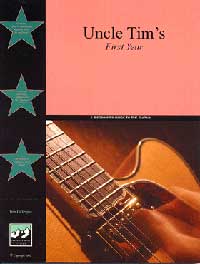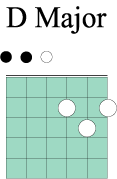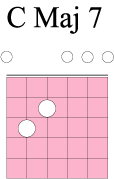

Get Your Musical Foundation In Place Now!
If you are struggling to know what chords are in what key or how the basic scale works within a key, you might be struggling when just a little information might make a HUGE difference.
You don't have to become a rules freak, but taking a little time to understand how a key works can take away ALL of that FRUSTRATION! And this is done visually so you do not need to read volumes to get it, just one thin book (88 pages).
Not knowing can stop your music right now and only understanding can make up for it. For $15, you can put this all to rest right now. Pick up a copy today.
eBooks are delivered instantly!
A friend of mine recently asked me where he could find some songs to play. My first question was, did you try the OLGA search engine? Which he had never heard of. In a few minutes he was delving into the archive but then he hit another unexpected problem. He does not know how to read tablature.
I gave him a few things to consider and he started to find some interesting songs right away. In one of the songs I showed him how certain passages were tabbed out so he could isolate that part and focus on it. His eyes lit up. "Now this makes sense" was his exclamation. Then he left to go play his guitar.
Guitarists are lucky. We have our own way of learning to play a song apart from musical notation. That is tablature.
For whatever reason, most guitarists do not read sheet music. I think it is because so few of the songs we want to learn are expressed in pure musical notation. Guitar is notated using the treble clef. Any piece you might play on the fretboard can be expressed using just a treble clef, but time and time again, available sheet music notates the piano part (if it exists) and relegates the guitar part to chord charts above the notation. This is less than perfect for learning guitar parts.
To have access to written music you want to learn a guitar part, can shave valuable time off the learning process. You simply look at the sheet music and start to figure out how the song works. Although you can find exceptions, most guitar parts simply do not show up in musical notation. The biggest exception to this is classical music. Classical music uses musical notation almost exclusively. But there is an alternate system to musical notation and it is specific to our instrument. Tablature!
Tablature is developed specifically for guitar, although you could easily apply it to the bass. It works very well for describing the exact sequence of notes played while including a sense of motion. Tablature can describe a song as it progresses through time, just like sheet music can. However, instead of notating the exact note like sheet music does, it illustrates where you put your fingers. This is more of a mechanical process than notation and so the basic premise of tablature is different from sheet music. This is offset by the exact nature of the instruction.
You can find lots of tablature for songs, in the search engine archives all over the Internet. Along with chord charting, this is the common form of written music for guitar parts. For me tablature is much easier to read and translate into music. I think visually and I like to get my information that way. I can easily sight read half of the tablature I have seen, but I cannot sight read notation at all. I do read music and I use it when available, but tablature is much simpler to use and more readily available. I suspect our brains do not get the same work out reading tablature as compared to reading musical notation. I usually do not have to work as hard.
In addition, artists like Eric Clapton allow their work to be illustrated in this medium which may be because it is favored by guitarists.
Tablature consists of six lines flowing across the page horizontally (flat). These six lines represent the six strings of a guitar. Here are the basic principles of reading tablature.
Example 1 - Basic tablature metaphor. Most tablature will look like this.
1. The first example illustrates the six strings of the guitar. This is just like you were looking at a fretboard in front of you, only you cannot see the frets.

Example 2 - The flow of time.
2. The second example adds the notion that time is expressed by moving to the right. This way an entire song can be illustrated if you have enough tablature.

Example 3 - D major chord.
3. The third example renders the common D major chord. For comparison the D major is also shown in chord chart form. Notice a few things here.
a. Only the top four strings are used.
b. The open D string is illustrated with a (0).
c. The dots and numbers tell you what fret to put your fingers on. In this example you would press down the high E string at the second fret (2), the B string at the third fret (3) and the G string at the second fret (2). The D string is played open. You choose which fingers to use.
With this method, notes are not even referenced. There is no mention that you are playing the F#, D, A and D notes. In my opinion this is one of the reasons why tablature is easier to understand and use than notation. It does not communicate the rich musical information available. I consider this it's major limitation too!
It is purely mechanical but don't let that stop you. Tablature is easy to use and can help you build up your song library fast.
d. Notice all the notes are played at the same time. Remember time is expressed as we move to the right. So any numbers shown exactly vertical from each other are played at the same time. This will become second nature with a little work.


Motion
Now lets look at how motion is applied to tablature. We are going to play a simple C major / A minor scale using tablature. I am including a flash animation from Uncle Tim's Teaching Center so you can see how the scale is played using graphics. The tablature and the flash loop are showing the exact same information. This tab will be smaller since we have more information to put in it. This size used in this example is more common.

This is the C major scale shown in tablature. It starts on the left hand side with an open string E note (0) and then illustrates the note on the first fret (1), then the third fret (3).
Then you play the open A string (0), then the note on the second fret (2) and then the third fret (3). Then you jump to the open D note (0), then the note on the second fret (2) and then the note on the third fret (3). Then you jump to the open G note (0), and then the note on the second fret of the G string (2). Then you move to the open B note (0), then the note on the first fret (1), and then the note on the third fret (3). Then you move over to the open E note on the high E string (0), then the note on the first fret (1), and the note on the third fret (3). When you reach the note on the third fret of the high E string you begin to play the exact same thing backwards. Try not to play that note twice. Look closely.
In this way the entire first position C scale is illustrated. Most people can sight read this with a little practice.
Did you notice we did not refer to any of the notes by name? That to me is a little freaky! We are isolating ourselves from the very names of the notes. This will not help you memorize them and that is important. So make sure you make yourself aware of the names of the notes.
Compare the flash animation to the static tablature. Each of these mediums communicates a slightly different set of information.
C Major Scale - First Position
As you examine different tablature, be aware of different variations in the uses of tablature.
Some tab will have difficult parts tabbed out and only include chord charts or chord names for the rest of the song. Other tab will bounce you back and forth as it describes different verses much the same way musical notation does.
Some tablature will have chord definitions, in modified tablature, for the chords used. So if you see a song referencing a GM7-5 ( G major 7 flat fifth), the song will provide an exact interpretation of how you play that chord. This is actually very nice because standard nomenclature leaves some ambiguity in describing chords exactly. So look for a little blurb somewhere in the tab for chord definitions.
Here is an example. The chord is referred is a C/B and here is the definition.
 C/B
= 032000
C/B
= 032000
This means play the low E open (032000), play the A string at the third fret (032000), play the D string at the second fret (032000) play the G, B and high E strings open (032000).
To the right is the chord chart for this chord and the last time I checked, we just described the C major 7 chord. But the song referred to it as a C/B. They are describing playing a C major chord with a B note added. So this is misleading to say the least. You will find many, many examples of this in tablature, so bring your brain with you and be prepared to use it.
One of the most positive aspects of tablature is there is usually a way to figure out the entire song. The author usually provides enough hints to allow you to get it, if you put in some time. But then again, maybe not!